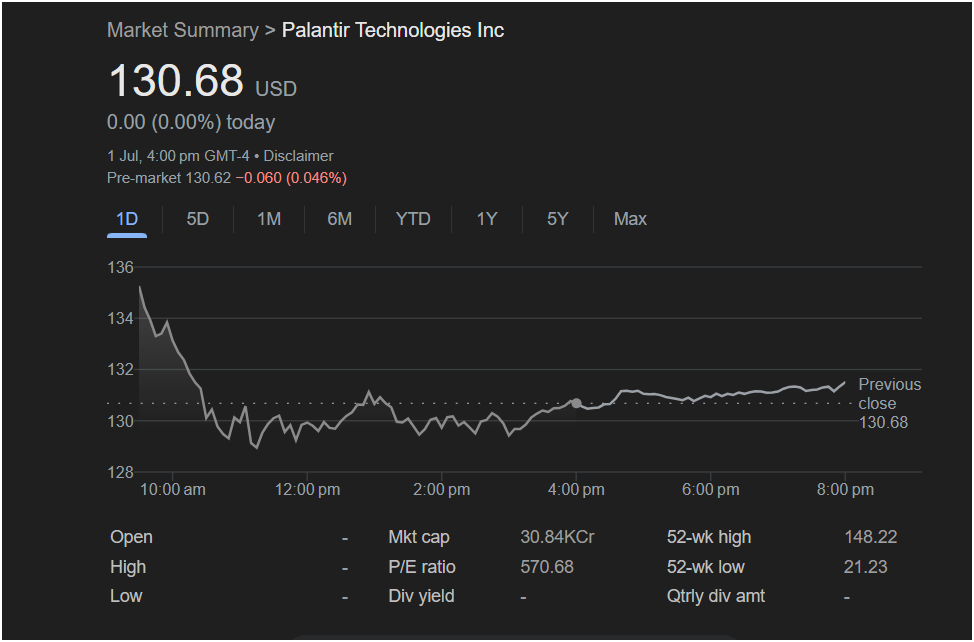Palantir Stock Ends Flat After a Day of Volatility: What Should Traders Watch for on Monday

Palantir stock (PLTR) closed the trading session on July 1st completely unchanged, finishing at $130.68 per share. While the 0.00% daily change suggests a quiet day, the intraday chart reveals a battle between bulls and bears that has left traders in a state of indecision heading into the next week.
For investors and traders looking at Palantir, understanding Friday’s volatile price action and key metrics is crucial for positioning for Monday’s market open.
A Closer Look at the Day’s Trading
A glance at the 1-day chart shows that Palantir’s flat close masks a turbulent session. The stock experienced a significant drop shortly after the market opened, falling from a high near the $135 mark to a low below $130. However, buyers stepped in at these lower levels, preventing a further slide.
For the remainder of the day, from approximately 11:00 am onwards, the stock entered a tight consolidation phase, trading sideways until the closing bell. This price action suggests a market in equilibrium—the initial selling pressure was met with enough buying support to stabilize the price, but there wasn’t enough bullish conviction to reclaim the morning’s losses. The stock’s finish right at its previous close of $130.68 is a clear sign of market indecision.
Key Metrics Every Trader Needs to Know
To build a complete picture, we must look beyond the daily chart:
-
Valuation (P/E Ratio): At 570.68, Palantir’s Price-to-Earnings ratio is exceptionally high. This indicates that investors have priced in massive future earnings growth. While this reflects strong confidence in the company’s technology and business model, it also makes the stock vulnerable to sharp pullbacks if it fails to meet these lofty expectations.
-
52-Week Performance: The stock is trading significantly closer to its 52-week high of

21.23. This shows powerful upward momentum over the past year, though it is currently trading about 12% off its peak.
-
Pre-Market Sentiment: The pre-market data shows a slight dip to $130.62, down 0.046%. While pre-market activity can be a weak signal, it suggests a potentially soft or bearish start to Monday’s session.
-
Dividends: As a growth-focused technology company, Palantir does not currently offer a dividend, meaning investors are banking solely on capital appreciation.
Outlook for Monday: Will the Stock Go Up or Down?
Based on the available data, Palantir stock is at a critical juncture. Here is what traders should be watching for:
The Bearish Case: The failure to recover from the morning sell-off, combined with a slightly negative pre-market indication, could signal weakness. If the stock breaks below the day’s low (around $129), it could trigger further selling as the consolidation resolves to the downside. The high P/E ratio remains a risk factor in a cautious market.
The Bullish Case: The fact that buyers defended the sub-$130 level is a positive sign. This consolidation could be the base from which the stock launches its next move upward. If broader market sentiment is positive on Monday, buyers may take control and push the price back towards the $135 level.
Conclusion: Is It Right to Invest Today?
For a short-term trader, the current situation presents uncertainty. The most prudent strategy may be to wait for a clear signal on Monday. A decisive move above the day’s consolidation range (roughly $131.50) could be a buy signal, while a break below the day’s low could be a signal to sell or stay away.
For a long-term investor who believes in Palantir’s fundamental growth story, this period of consolidation might be seen as a stable entry point. However, the high valuation demands a strong tolerance for risk and volatility.
Ultimately, Monday’s opening price action will be key. Watch to see if the stock can hold its support level or if the sellers from Friday’s session will re-emerge in force.
Disclaimer: This article is for informational and analytical purposes only. It is not financial advice. All investment decisions should be made based on your own research and consultation with a qualified financial advisor.

